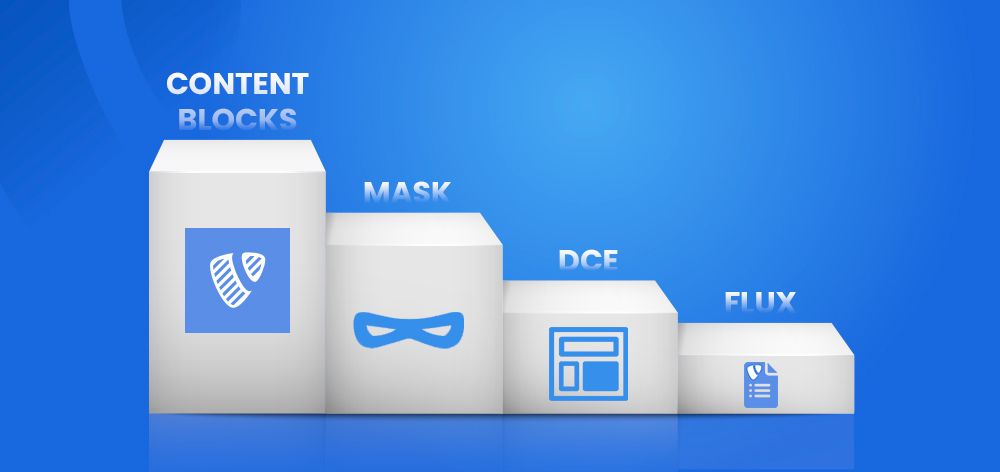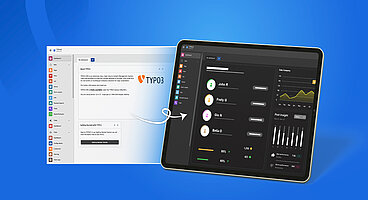Building modern, flexible, and editor-friendly TYPO3 pages isn't just about design—it's about choosing the right approach. With TYPO3 Fluid templating, you have multiple options like Content Blocks, Mask, DCE, and Flux. But which is best for your needs?
In this guide, we’ll break it down for developers, editors, and project managers who want clarity and future-proof decisions.
If you're new to TYPO3 Content Blocks, Mask, Flux, or DCE, and want to understand the basics before comparing them, we recommend reading the following detailed guides:
What is TYPO3 Content Blocks?
TYPO3 Content Blocks are a modern and flexible way to define and manage content components within TYPO3 CMS. Introduced to improve the developer experience and streamline content creation, content blocks follow a component-based approach, allowing you to build reusable and customizable content elements across your TYPO3 projects.
Benefits of TYPO3 Content Blocks
- Standardized Structure:
Content blocks follow a clear and unified format using YAML and TCA (Table Configuration Array). - Reusable Components:
You can create blocks once and reuse them across multiple pages or templates. - Extensibility:
Easily extend or modify blocks as your website grows. - Simplified Development:
Reduces the complexity of creating custom content types in TYPO3. - Seamless Integration:
Content blocks can be included as part of your TYPO3 extensions, ensuring modular and scalable development.
Why Flexible Content Matters in Modern TYPO3 Fluid Sites?
With Fluid, each block (called a content element) can be designed exactly the way you need. You don’t have to follow fixed page layouts anymore. This gives editors more freedom to tell their stories and keep the design consistent.
- Cut time‑to‑publish by up to 70 % with reusable components
- Keep design consistency across hundreds of pages
- Future‑proof upgrades—especially critical as TYPO3 v14 will ship Content Blocks natively in the core
Real-Life Example
Let’s say you run a TYPO3-based travel blog. Using flexible content, you can:
- Add a banner with a destination photo
- Follow with a short travel story block
- Add a list of tips in a bullet block
- Insert a contact form or booking button
All done without any coding. That’s the power of flexible content.
Best TYPO3 Template Techniques in 2025
TYPO3 Content Blocks (Core, v12 LTS ➜ integrate in v14)
- Approach: YAML + contentblocks: CLI scaffolding → PHP classes
- Use‑Case: Core‑backed, upgrade‑safe page components
- Stand‑Out: Native to TYPO3, zero runtime dependency
CLI Example:
# Scaffold a new "hero_image" block inside your sitepackage
vendor/bin/typo3 contentblocks:generate MyVendor.SitePackage hero_imageTYPO3 Mask
- Approach: GUI wizard generates TCA, Fluid, language labels
- Use‑Case: Rapid prototyping; editors love its preview wizard
- Stand‑Out: Zero‑code prototype; active community
TYPO3 DCE (Dynamic Content Elements)
TYPO3 DCE, short for Dynamic Content Elements, is a popular TYPO3 extension that lets you create custom content elements — without writing complex code.
It's especially helpful when you need structured, reusable content like team member profiles, service cards, testimonials, or product features.
- Approach: Backend module generates new CType definitions
- Use‑Case: Structured data (e.g., “team profiles”) with Fluid
- Stand‑Out: Field‑level configuration granularity
TYPO3 Flux / EXT:fluidcontent
TYPO3 Flux and its companion extension EXT:fluidcontent are advanced tools that bring maximum flexibility and control to your TYPO3 templates and content elements. They allow you to create fully dynamic layouts, nested content areas, and custom backend structures using a combination of Fluid templating, FlexForms, and TypoScript.
- Approach: Configuration in Flexform + TypoScript
- Use‑Case: Highly dynamic layouts, nested grids, multi‑variant templates
- Stand‑Out: Extreme flexibility—steeper learning curve
TYPO3 Content Blocks vs Mask vs DCE vs Flux
| Criteria | Content Blocks | Mask | DCE | Flux |
| Learning Curve | Low‑Medium (YAML + PHP) | Low (GUI) | Medium | High |
| Backend UX | Native BE preview | Drag‑n‑drop preview | Form‑based | Flexible grids |
| Upgrade Safety | Core supported (v14+) | Needs upkeep | Needs upkeep | Heavy upkeep |
| Performance | Excellent (no extra runtime) | Very good | Good | Good–OK (ViewHelpers) |
| Extensibility | Hooks & PHP classes | TCA overrides | Field configs | Nested components |
| Typical Use‑Case | Enterprise, future‑proof | Agency sprints | Data‑heavy modules | Complex landing pages |
Pro Tip: Performance and upgrade safety improve dramatically when your solution lives inside the TYPO3 core. Less code ⇒ less technical debt.
Pros and Cons Breakdown
1.TYPO3 Content Blocks
- Strengths: Core API, strict schema validation, native translation handling, testable PHP classes, CI‑friendly scaffolding.
- Weaknesses: Younger ecosystem (introduced in v12); limited GUI—developers must touch code (good news for us!).
2. TYPO3 Mask
- Strengths: Fastest prototyping path, intuitive wizard, active Slack support.
- Weaknesses: Generated code can bloat repos; manual fixes needed during major upgrades.
3. TYPO3 DCE
- Strengths: Perfect for repeatable, data‑centric elements (e.g., staff directory); fine‑grained field control.
- Weaknesses: Each DCE instance renders its own Flexform—can affect render time on heavy pages.
4. TYPO3 Flux
- Strengths: Grid containers, variant templates, dynamic field conditionals—almost limitless.
- Weaknesses: Steep learning curve; migrations from v9→v13 require planning; runtime overhead from ViewHelpers.
Winner: Why We Recommend Content Blocks
After benchmarking upgrade paths, performance metrics, and editor feedback, TYPO3 Content Blocks emerge as the clear winner for projects focused on longevity and core alignment. With official integration planned for TYPO3 v14 LTS, they strike the right balance between structure and flexibility while keeping technical debt low.
- Upgrade‑Safe: Backed by the core team—no third‑party breakage worries.
- Lean Runtime: Only YAML + PHP; no additional ViewHelpers.
- Automation‑Ready: CLI scaffolding slots perfectly into CI/CD pipelines.
- Future‑Proof: Roadmap shows continuous improvements in upcoming TYPO3 versions.
TYPO3 Migration & Co-Existence Tips
- TYPO3 lets you run Mask, DCE, Flux, and Content Blocks side‑by‑side—migrate gradually.
- Prototype your most‑used Mask elements as Content Blocks; then flag the originals as hidden.
- Use the (upcoming) contentblocks:convert CLI (v13) to auto‑generate YAML from legacy TCA definitions.
5-Step TYPO3 Content Method Checklist
1. Define longevity. How many major TYPO3 versions will you support?
2. Assess editor skills. GUI vs form fields vs code.
3. Benchmark performance. Load‑test pages with 50+ dynamic elements.
4. Count dependencies. Fewer extensions = fewer upgrade headaches.
5. Prototype quickly. Build one element in two frameworks and compare velocity + UX.
Conclusion
As TYPO3 continues to evolve, it's essential to keep your content architecture modern, scalable, and upgrade-friendly. While tools like Mask, DCE, and Flux have served well in various use cases, TYPO3 Content Blocks represent the future — with core support, cleaner structure, and long-term stability, bringing significant wins for your projects.
If you're looking for a solution to migrate from Flexform to TCA, T3Planet offers a complete service to help you make the move smoothly and safely.
Until we meet again — Happy TYPO3ing!
FAQ
Yes. TYPO3 treats each CType independently, so you can migrate progressively—just avoid duplicate identifiers.
No. While Content Blocks are our top pick for future‑proof builds, the community still maintains the other extensions. Choose what fits your roadmap
TYPO3 v13 has integrated several features from Content Blocks into its core, including:
- Schema API
- Automatic transformation of TCA field values for record objects
- RecordTransformation Data Processor
YAML is chosen for its readability and ease of use, making it accessible to both frontend and backend developers. It supports comments and allows for IDE auto-completion through JSON schemas, facilitating a smoother development experience.
Officially they arrive in v14 LTS. Back‑ports exist but lack core support—use them only for prototypes.
Mask’s GUI remains the quickest path for designers or editors who don’t write code. But hopefully, Content blocks will also get GUI soon.
Challenging—Flux stores configuration in Flexform. Plan a migration script or refactor to Content Blocks over several sprints.
Yes, Content Blocks generate standard TYPO3 core code (TCA, TypoScript, etc.), making them compatible with headless configurations. However, you need to set up your headless environment accordingly, just as you would with core content elements.






Wolfgang Weber
Brand & Communication LeadWolfgang Weber shapes TYPO3 with passion and expertise. As TYPO3 enthusiast, he has contributed to TYPO3 projects that make websites faster and more secure. Outside of TYPO3, you'll probably find him exploring local cafés and…
More From Author